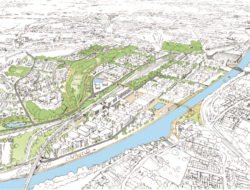In 2015, Facebook employees moved into new premises built by Frank Gehry, designer of the Guggenheim museum in Spain. With this campus extension, located in Menlo Park, the social network congratulated itself on moving into the “biggest open office in the world”, a vast building of one room of 40,000 square metres. But on this same site, Facebook is completing an 80-hectare project: Zee Town. A “private town” dedicated to its 10,000 employees, with supermarkets, hotels, villas and even dormitories for the group’s trainees.
The social network’s founder is not the only one practising this “paternalism version 3.0”. Amazon is currently building three giant glass spheres in Seattle. Google’s future headquarters also packages itself as “the glass Utopia”: translucent domes, designed to be reconfigurable as jobs and innovations appear. Designed by the Dane Bjarke Ingels and the British designer Thomas Heatherwick respectively, Googleplex represents a new form of work organisation. The employee must have the feeling of being more than just that, of blossoming while working for the growth of the company, of participating in something bigger than him-herself.
The same applies to the Apple “spaceship”, conceived by Norman Foster. Destined to become Apple’s brand new headquarters, this megacomplex located in Cupertino will be opened next April. With a central building in the shape of a futurist ring, coated in curved glass, this futuristic campus covering 260,000 square metres – officially named “Apple Park” – will soon welcome over 12,000 Apple employees. Aside from the “architecture”, the place is also inspired by the isolationist values of university campuses or even the social planning of the corporate towns.
Private town boom in India
Very common in the early 20th century, the idea of the corporate town has been revived by the giants of the Silicon Valley. But the emerging countries, like India and Saudi Arabia, are home to the most ambitious towns entirely managed by the private sector. India has 4,000 free-trade zones part of which will become private towns. One of the most recent examples of this is Magarpatta City, a secure enclave for the wealthy, located in Pune, about sixty miles from Mumbai. Entirely privatised, the 160-hectare complex was designed to house the 35,000 employees of the IT companies established in the Cybercity. A little further away, 120 or so miles Southeast of Mumbai, the consortium HCC started out ten years ago on the construction of a city covering 100 square kilometres, Lavasa. The project, whose magnitude far exceeds Apple’s or Facebook’s dreams has seen strange, Italian-inspired buildings take shape in India’s mountains. In the long run, Lavasa should be home to over 200,000 inhabitants. And in the face of unprecedented demographic growth, 24 new towns of this type could materialise in the industrial corridor between New Delhi and Mumbai, as well as a future international finance centre, the Gujarat International Finance Tec-City.
In Saudi Arabia, the King Abdullah Economic City (Kaec) aims to house nearly 2 million inhabitants by 2035. In the case of the KAEC, a public-private partnership was signed between the Saudi government and a Dubai real-estate group, Emaar Properties. Its inhabitants don’t pay taxes, but “service costs” for security, water and waste collection, which are subcontracted to different contractors. The most amazing thing about this new Utopia is: the city doesn’t even have a mayor. It is governed by the CEO of Emaar Economic City (EEC), Fahd Al Rasheed.
Tags: Apple Park, Googleplex, Kaec, Lavasa, Zee Town



































